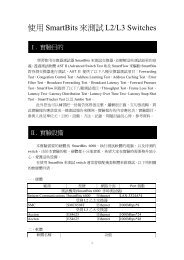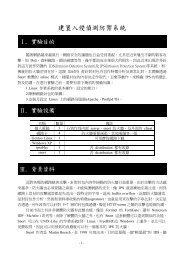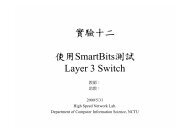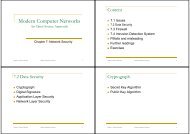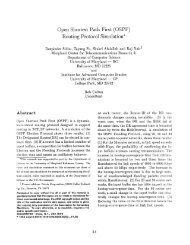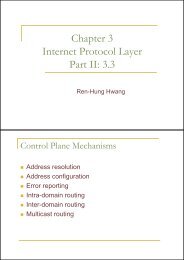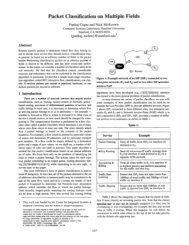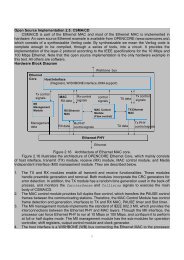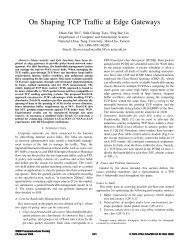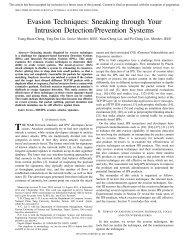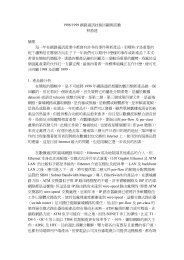Fundamental Questions to Answer About Computer Networking, Jan ...
Fundamental Questions to Answer About Computer Networking, Jan ...
Fundamental Questions to Answer About Computer Networking, Jan ...
You also want an ePaper? Increase the reach of your titles
YUMPU automatically turns print PDFs into web optimized ePapers that Google loves.
<strong>Fundamental</strong> <strong>Questions</strong> <strong>to</strong> <strong>Answer</strong> <strong>About</strong> <strong>Computer</strong> <strong>Networking</strong>, <strong>Jan</strong> 2002Prof. Ying-Dar Lin, ydlin@cis.nctu.edu.twChapter 1: Introduction1. How does Internet scale <strong>to</strong> 100M hosts?2. Routing vs. switching?stateless vs. stateful?connectionless vs. connection-oriented?indexing vs. matching?3. Latency inside Internet? (queuing, transmission/processing, propagation)4. What do Little’s result and bandwidth-delay product tell us?5. What does the end-<strong>to</strong>-end argument say about networking?6. Where <strong>to</strong> do error control in Internet? Why in Ethernet, IP, TCP, UDP?7. What <strong>to</strong> do in control-plane and data-plane?8. What are standard and implementation-dependent components in a router?9. What’s inside a Linux/BSD distribution?10. How does a Linux/BSD system boot up?11. What <strong>to</strong> implement in ASIC, driver, kernel, and daemon of a Linux/BSD-based router?Chapter 2: Data Link Layer1. What are the byte and bit orders in IP over Ethernet?2. Why FCS at the tail? IP Checksum in the header?3. Why is big bandwidth delay product bad for CSMA/CD?4. What is the problem in half-duplex gigabit Ethernet?5. What is the maximum frame length, in meter, when transmitted in Gigabit Ethernet?6. Why not CSMA/CD for Wireless LAN? (What are the differences between CSMA/CD andCSMA/CA?)7. What problem does the RTS/CTS mechanism solve for CSMA/CA in wireless LAN?8. What are the differences between collision domain, broadcast domain, and VLAN?9. Layer-2 bridging vs. layer-3 routing?10. Layer-2 bridging in a large campus network? Why not?11. Why do we say bridges are transparent <strong>to</strong> hosts while routers are not?12. Why do we need a spanning tree in transparent bridging?13. How <strong>to</strong> Program a MAC in an IC? Input? Output? Variables? How about a driver?14. How do you compile, install, and run a Linux/BSD driver?15. What does a network adap<strong>to</strong>r driver want when it probes the hardware? For what?16. What interrupts may lead a system <strong>to</strong> execute a network adap<strong>to</strong>r driver?Chapter 3: IP Layer1. Why do we need both Ethernet address and IP address for an interface?2. Why are Ethernet addresses flat while IP addresses hierarchical?3. How is netmask used inside a router and a host?4. Routing vs. forwarding?5. Why there could be multiple matched IP prefixes in router’s table lookup?6. How is the longest-prefix matching done in the Linux kernel? Why is the matched prefixguaranteed <strong>to</strong> be the longest?7. How is the forwarding table organized in the Linux kernel?8. What header fields are needed in IP reassembly at destination hosts?9. What packet modifications are needed for FTP through NAT?10. What packet modifications are needed for ICMP through NAT?11. How is the NAT table implemented in the Linux kernel?12. What header fields in IPv4 are removed or moved in the header of IPv6? Why?13. How can IPv4 and IPv6 co-exist?14. How does a host translate IP addresses <strong>to</strong> MAC addresses through ARP?15. How does a host obtain its IP address through DHCP or ARP?16. How are “ping” and “traceroute” implemented with ICMP messages?17. How does the count-<strong>to</strong>-inifnity problem occur in RIP?18. RIP vs. OSPF? (in terms of network state information and route computation)19. Distance vec<strong>to</strong>r routing vs. link state routing?20. RIP vs. BGP?21. Why do RIP, OSPF, and BGP run over UDP, IP, and TCP, respectively?22. Can you estimate the number of routing table entries in intra-AS and inter-AS routers?23. How do routing pro<strong>to</strong>cols in “zebra” exchange messages with other routers and updaterouting tables in the kernel?24. How does a router know through IGMP whether hosts in its subnet have joined a multicastgroup?25. Does a router know exactly which hosts have joined a multicast group?26. Source-based vs. core-based multicast tree?27. What state information is kept in routers for source-based and core-based multicast routers?Which is more scalable?28. Do packets really flow on the shortest path in the reverse path multicasting in DVMRP?29. What state information is kept in routers for the reverse path multicasting in DVMRP?30. How is the RP of a multicast group determined in PIM-SM?Chapter 4: Transport Layer1. Layer-2 channel vs. layer-4 channel?2. TCP vs. UDP?
3. Why does most real-time traffic run over UDP?4. What mechanisms are needed <strong>to</strong> support error control in TCP?5. Why does TCP need 3-way handshake, instead of 2-way, in connection setup?6. When is a lost TCP segment retransmitted?7. What fac<strong>to</strong>rs are considered in deciding the TCP window size?8. How does the window grow in slow-start and congestion avoidance?9. Why are fast retransmit and fast recovery added <strong>to</strong> TCP?10. How is the socket implemented in Linux/BSD?11. What are available in the kernel-space and the user-space of Linux/BSD <strong>to</strong> filter andcapture packets?12. What extra support can be done over RTP and RTCP than UDP?3. What are the problems with InteServ?4. What are the problems with DiffServ?Chapter 7: Internet Security1. VPN: IPsec, L2TP, PPTP?2. Packet-filter vs. application-proxy firewalls?3. Hackers’ tricks?4. IDS’s signatures?Chapter 5: Internet Services1. Why are pro<strong>to</strong>col messages of most Internet applications ASCII and variable length?2. Why do servers running over TCP and UDP have concurrent and iterative implementations,respectively?3. How do DNS servers resolve a domain name in<strong>to</strong> an IP address?4. How do DNS servers resolve an IP address in<strong>to</strong> a domain name?5. What resource records are used in forward-DNS and reverse-DNS?6. What entities and pro<strong>to</strong>cols are involved if you send a mail for your friend <strong>to</strong> read?7. POP3 vs. IMAP4?8. What POP3 messages are exchanged when you download mails from the server?9. What HTTP messages are exchanged in downloading, filling, and uploading a Web form?10. What does the connection persistence mean in HTTP 1.1?11. Forward-caching vs. reverse-caching?12. How does an HTTP proxy intercept HTTP requests destined <strong>to</strong> HTTP servers?13. What does an HTTP caching proxy do if it has a cache miss?14. How does “squid” implement the data structure and algorithm for caching?15. Active mode vs. passive mode in FTP?16. Control and data connections in FTP?17. What pro<strong>to</strong>col messages are exchanged in downloading and uploading a file in FTP, usingactive mode and passive mode?18. Why is streaming quite robust <strong>to</strong> Internet delay and jitter?Chapter 6: Internet Quality of Services1. What control-plane and data-plane mechanisms are needed <strong>to</strong> provide QoS guarantee inInternet?2. Per-flow IntServ vs. per-class DiffServ?



